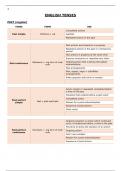Study guide
IB Biology IA: Enzymes
- Cours
- Établissement
Level 7 IA (22/25 points) conducted on topic 2.5 (enzymes). The IA explored what affect does Enzyme Trypsin has on protein Casein which is contained in milk. In addition to that, the IA explores how inhibitor ethanol affects the rate of the reaction.
[Montrer plus]









